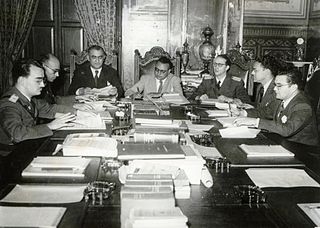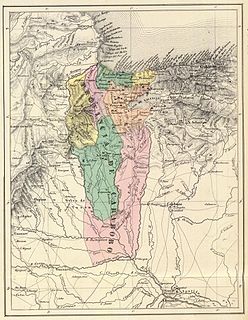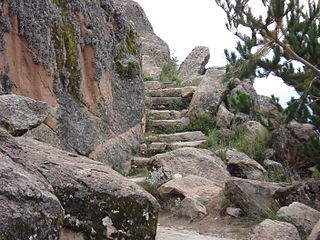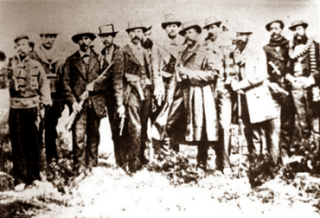 W
WThe 1945 Venezuelan coup d'état took place on 18 October 1945, when the president Isaías Medina Angarita was overthrown by a combination of a military rebellion and a popular movement led by Democratic Action. The coup led to a three-year period of government known as El Trienio Adeco, which saw the first participant presidential elections in Venezuelan history, beginning with the 1946 Venezuelan Constituent Assembly election. The 1947 Venezuelan general election saw Democratic Action formally elected to office, but it was removed from office shortly after in the 1948 Venezuelan coup d'état.
 W
WApure Province was a province of Gran Colombia, and later one of the provinces of Venezuela, after Venezuelan independence in 1830. It was created in 1823, being split from Barinas Province, with the Uribante River and Apure River marking the border. The following year, Gran Colombia was reorganised into four Departments, with the Apure Department consisting of Apure Province and Barinas Province. Its capital was Achaguas, for which the Province was sometimes called Achaguas Province.
 W
WThe Cara culture flourished in coastal Ecuador, in what is now Manabí Province, in the first millennium CE.
 W
WCarabobo Province (1824–1864) was one of the provinces of Gran Colombia, and later one of the provinces of Venezuela, after Venezuelan independence in 1830. It was split from Caracas Province. In Gran Colombia it belonged to the Venezuela Department which was created in 1824.
 W
WThe 1641 Caracas earthquake took place in Venezuela on 11 June 1641. It is often known as the San Bernabé earthquake because 11 June is the feast day of Barnabas in the Catholic calendar. The earthquake caused extensive damage in Caracas and the destruction of La Guaira; the event led the Caracas city council to propose rebuilding its city in what was then the savannah of Chacao, a move that was opposed by the Governor, Ruy Fernández de Fuenmayor.
 W
WChinkana is an archaeological site in Bolivia situated on the Isla del Sol, an island of Lake Titicaca. It is located in the La Paz Department, Manco Kapac Province, Copacabana Municipality.
 W
WThe Colombian Battalion was a Colombian Army Infantry battalion that served with the United Nations Command during the Korean War. The first Colombian military unit to serve in Asia, the Colombian Battalion was attached to the US 7th Infantry Division and 25th Infantry Divisions during the war. The battalion was deployed from 1951 to 1954.
 W
WThe Congress of Panama was a congress organized by Simón Bolívar in 1826 with the goal of bringing together the new republics of Latin America to develop a unified policy towards Spain. Held in Panama City from 22 June to 15 July of that year, the meeting proposed creating a league of American republics, with a common military, a mutual defense pact, and a supranational parliamentary assembly.
 W
WThe Dutch–Venezuelan crisis of 1908 was a dispute that broke out between the Netherlands and Venezuela after the Venezuelan president, Cipriano Castro, cut off trade with the Dutch island of Curaçao on the grounds that it was harbouring political refugees from Venezuela.
 W
WEl Morro del Tulcán is an Indigenous pyramid in Popayán, Colombia. Research suggests that the individuals buried there came from the very top of the social classes of their society.
 W
WThe Federal War — also known as the Great War or the Five Year War — was a civil war (1859–1863) in Venezuela between the Conservative party and the Liberal party over the monopoly the Conservatives held over government positions and land ownership, and their intransigence to granting any reforms. This drove the Liberals – known as the Federalists – to look for greater autonomy for the provinces: a new federalism for Venezuela, as it were. It was the biggest and bloodiest civil war that Venezuela had since its independence from Spain on 5 July 1811. Hundreds of thousands died in the violence of the war, or from hunger or disease, in a country with a population of just over a million people.
 W
WThe Free and Independent State of Cundinamarca was a rebel state in colonial Colombia, replacing the Spanish colonial Viceroyalty of New Granada from 1810 to 1815. It was part of the Foolish Fatherland period at the beginning of the Spanish American wars of independence. Its capital was Bogotá, the former capital of the Viceroyalty of New Granada.
 W
WNew León Governorate or Magellanic Lands (1529−?) was one of the colonial governorates of the Spanish Empire, located in southern South America.
 W
WIñaq Uyu, also called Aklla Wasi, is an archaeological site in Bolivia situated on the Isla de la Luna, an island of Lake Titicaca. It is located in the La Paz Department, Manco Kapac Province, Copacabana Municipality In Incan society, the societal structure was very rigid. Often those of belonging to the royal class structure did not mix with the lower classes.
 W
WInkallaqta is a monumental Inca site in central Bolivia. It is located in the Cochabamba Department, Carrasco Province, Pocona Municipality, approximately 130 kilometers east of Cochabamba. It was most recently excavated by Larry Coben.He believes that the site was used to perform rites for the ceremonial calendar. The site has several important structures such as the Kallanka. It was the largest single roofed room in the western hemisphere when it was built, and measures 78 by 25 meters. There's also an ushnu or a ritual platform on the site. The Torreon of Inkallaqta is also located on this site. Located at the western side of the site this six sided structure supposedly had calendrical or astronomical significance. There is a zigzag wall immediately north of the site which is meant to mark and protect it.
 W
WJach'a Phasa is an archaeological site in Bolivia located in the La Paz Department, Pacajes Province, Calacoto Municipality, about 2 km north-east of Rosario. It is situated at a height of 4,126 metres (13,537 ft) on top of the mountain Jach'a Phasa north of the Mawri River.
 W
WKilling Pablo: The Hunt for the World's Greatest Outlaw (2001) is a book by Mark Bowden that details the efforts by the governments of the United States and Colombia, their respective military and intelligence forces, and Los Pepes to stop illegal activities committed by Colombian drug lord Pablo Escobar and his subordinates. It relates how Escobar was killed and his cartel dismantled. Bowden originally reported this story in a 31-part series published in The Philadelphia Inquirer and in a companion documentary of the same title.
 W
WLa Grita Province was a province of the Spanish Empire in the 17th century (1576–1607), with La Grita as its capital. In 1607 it merged with Mérida to form what became known as Mérida Province.
 W
WMaracaibo Province or Maracaybo Province from 1676 to 1824 was a province of the Spanish Empire. It resulted from a merger of the former Province of Mérida with the territory of Maracaibo.
 W
WMichima Lonco was a Picunche chief said to be a great warrior, born in the Aconcagua Valley and educated in Cusco by the Inca Empire. He presented himself to the Spaniards, naked and covered by a black pigmentation.
 W
WNew Andalusia Province or Province of Cumaná (1537–1864) was a province of the Spanish Empire, and later of Gran Colombia and Venezuela. It included the territory of present-day Venezuelan states Sucre, Anzoátegui and Monagas. Its most important cities were the Capital City Cumaná and New Barcelona.
 W
WNew Andalusia Governorate was one of the colonial governorates of the Spanish Empire, located in southern South America.
 W
WPachat'aqa, possibly erroneously also named Horca del Inca in Spanish, is an archaeological site in Bolivia situated near Lake Titicaca. It lies in the La Paz Department, Manco Kapac Province, Copacabana Municipality, near Copacabana.
 W
WPillkukayna is an archaeological site on the shore of the island of Isla del Sol in the southern part of Lake Titicaca in Bolivia. It is situated in the La Paz Department, Manco Kapac Province, Copacabana Municipality.
 W
WAmbrosio de La Plaza y Obelmejia was a military figure involved in the Venezuelan War of Independence. Born in Caracas, he joined the army at the age of 19. He fought under Francisco de Miranda and later served under Simón Bolívar. Involved in operations against royalist forces entrenched in Bogotá in 1814, he later fled with Bolívar to Jamaica and Haiti.
 W
WMérida Province was a province of the Spanish Empire in the 17th century (1622–1676), with Mérida as its capital. It was part of the New Kingdom of Granada, and was formed initially in 1607 with a merger with the La Grita Province, forming an administrative unit below province status, which it attained in 1622. In 1676 it merged with Maracaibo to form what became known as Maracaibo Province.
 W
WAccording to the constitution of 1832, the territory of the Republic of New Granada was divided into provinces. Each province was composed of one or more cantons, and each canton is several divided into districts parish.
 W
WQhunqhu Wankani is an archaeological site in Bolivia located in the La Paz Department, Ingavi Province, Jesús de Machaca Municipality. It is situated south of Lake Wiñaymarka, the southern part of Lake Titicaca, and south of Tiwanku, near the village Qhunqhu Liqiliqi.
 W
WThe Quimbaya artifacts are several dozen golden objects, found in Colombia, made by the Quimbaya civilization culture, dated around 1000 CE, a few of which are supposed to represent modern airplanes, and therefore to be out-of-place artifacts. The whole of the figurines, measuring 2 to 3 inches each, are described in mainstream archaeology as depicting birds, lizards, amphibians and insects common in that region and period, some of them highly stylized, as in the Gold Museum, Bogotá.
 W
WQuito Department was one of the three departments of Gran Colombia until 1824.
 W
WThe Simón Bolívar Guerrilla Coordinating Board was an umbrella group of guerrilla organizations in Colombia from 1987 to the early 1990s. The Revolutionary Armed Forces of Colombia, the 19th of April Movement, the National Liberation Army, the Popular Liberation Army, Workers Revolutionary Party and the Movimiento Armado Quintin Lame were all members of the CGSB. Subsequently, the FARC-EP and the ELN only continued in the Coordinator until 1994 to continue the armed struggle separately, after the M-19, the Quintin Lame, the EPL, and the WRPC in 1991.
 W
WSpanish Venezuelans are Venezuelan citizens of Spanish origin or descent. There are many Venezuelans of Spanish origin, especially from the Canary Islands. Most Venezuelans have some Spanish ancestry.
 W
WThe Supreme Junta was the institution that governed the Captaincy General of Venezuela following the forced resignation of the Captain General Vicente Emparán on April 19, 1810, marking the beginning of the Venezuelan War of Independence. It lasted until March 2, 1811, when the first constituent congress of the First Republic of Venezuela was established.
 W
WThe Táchira helicopter crash was the loss of a Venezuela Army helicopter and its 18 occupants on 3 May 2009. The helicopter crashed at around midday local time near El Alto de Rubio in the north-western state of Táchira in Venezuela. All eighteen people aboard the aircraft were killed. The dead included one Brigadier-General, two army pilots, fourteen other army personnel and one civilian. Venezuelan President Hugo Chávez, who was a retired army Lieutenant-Colonel, announced the incident in his weekly television broadcast and said "I pay tribute to these soldiers of the homeland, especially Gen Faneite, who was my cadet".
 W
WThe Battle of Calama or Battle of Topáter was fought on March 23, 1879 between Chile and Bolivia, and was the first battle of the War of the Pacific.
 W
WThe Treaty of Petrópolis, signed on November 11, 1903 in the Brazilian Imperial city of Petrópolis, near Rio de Janeiro, ended tensions between Bolivia and Brazil over the then-Bolivian territory of Acre, a desirable territory during the contemporary rubber boom.
 W
WUpper Peru is a name for the land that was governed by the Real Audiencia of Charcas. The name originated in Buenos Aires towards the end of the 18th century after the Audiencia of Charcas was transferred from the Viceroyalty of Peru to the Viceroyalty of the Río de la Plata in 1776. It comprised the governorships of Potosí, La Paz, Cochabamba, Chiquitos, Moxos and Charcas.